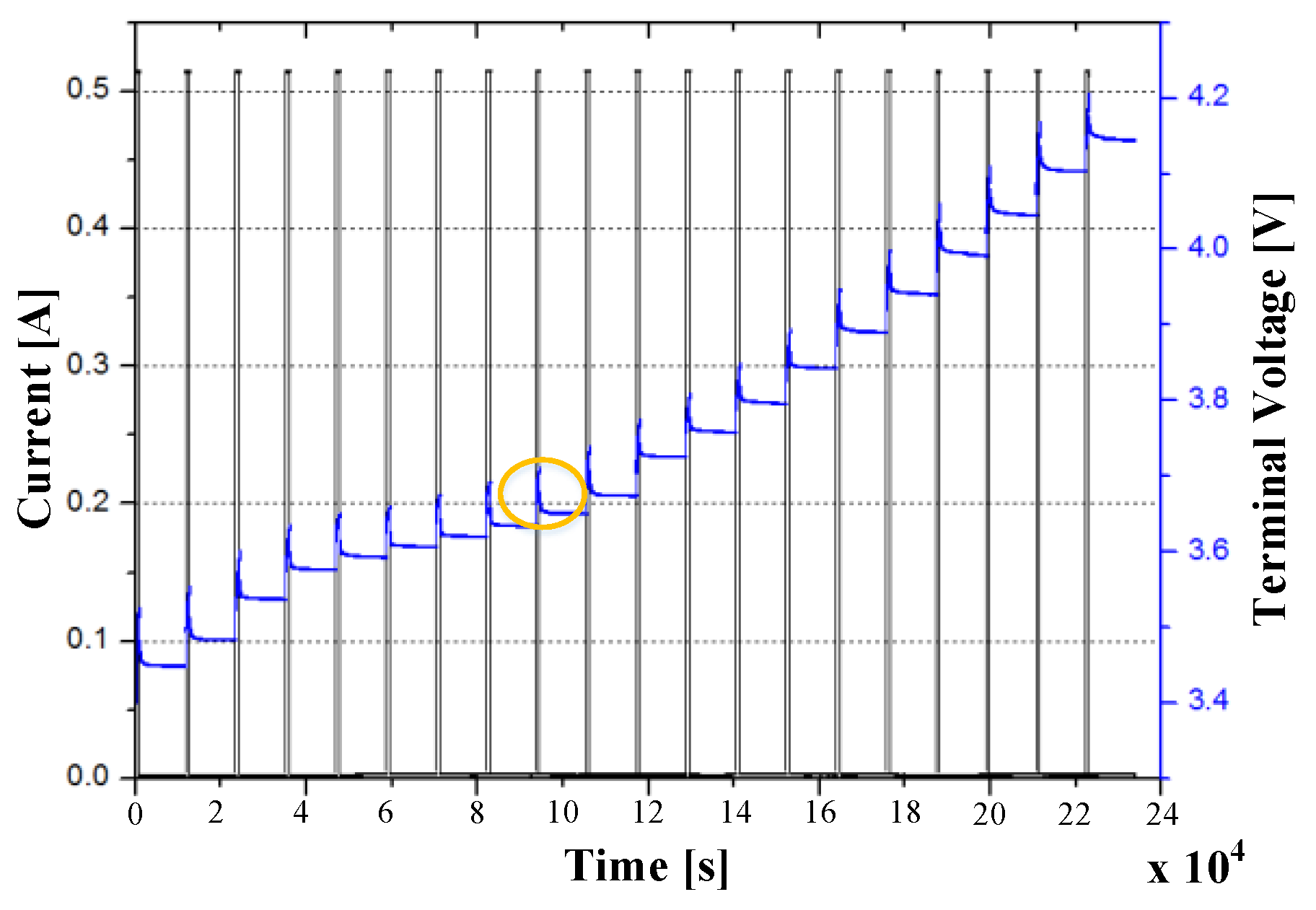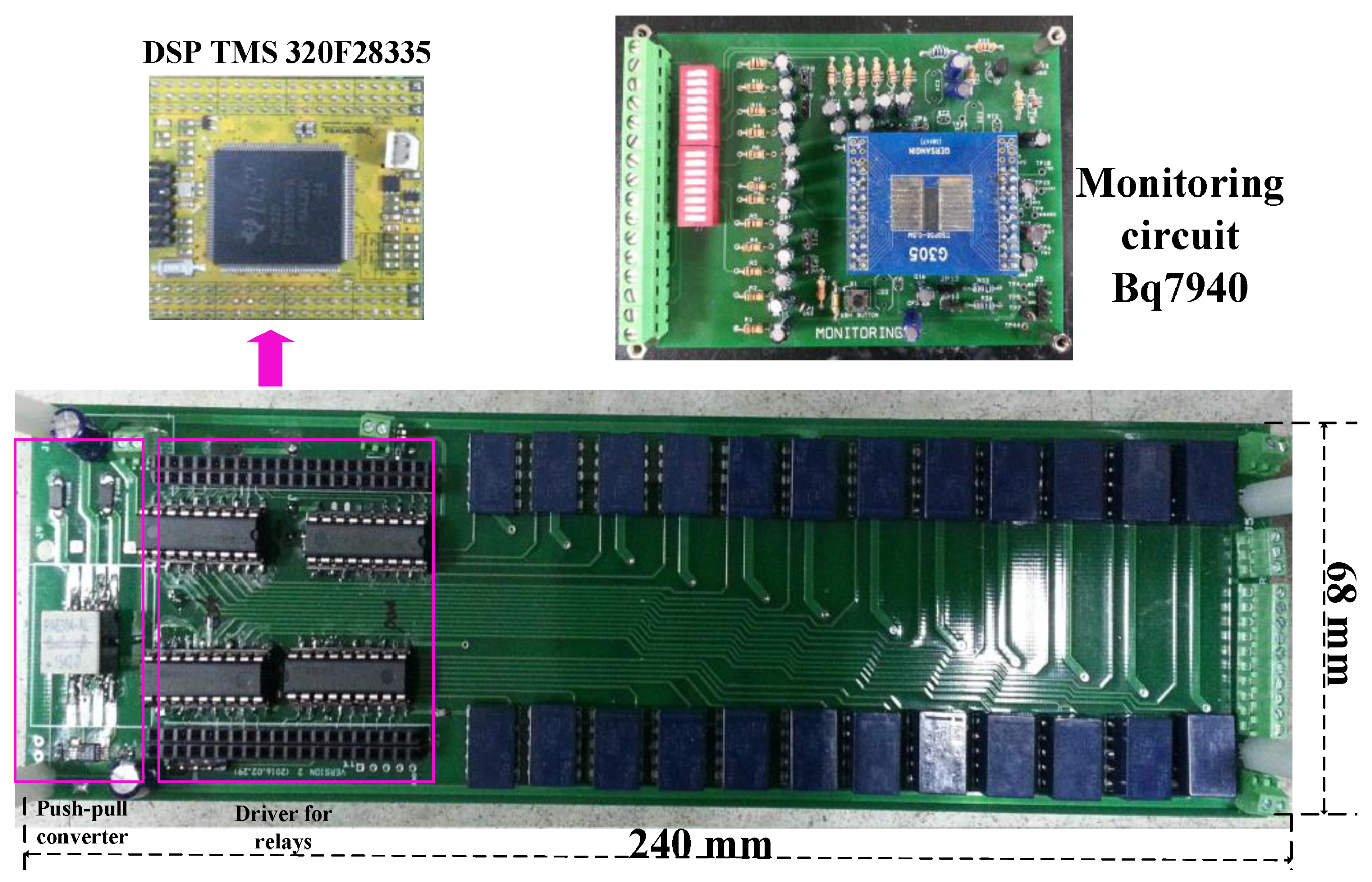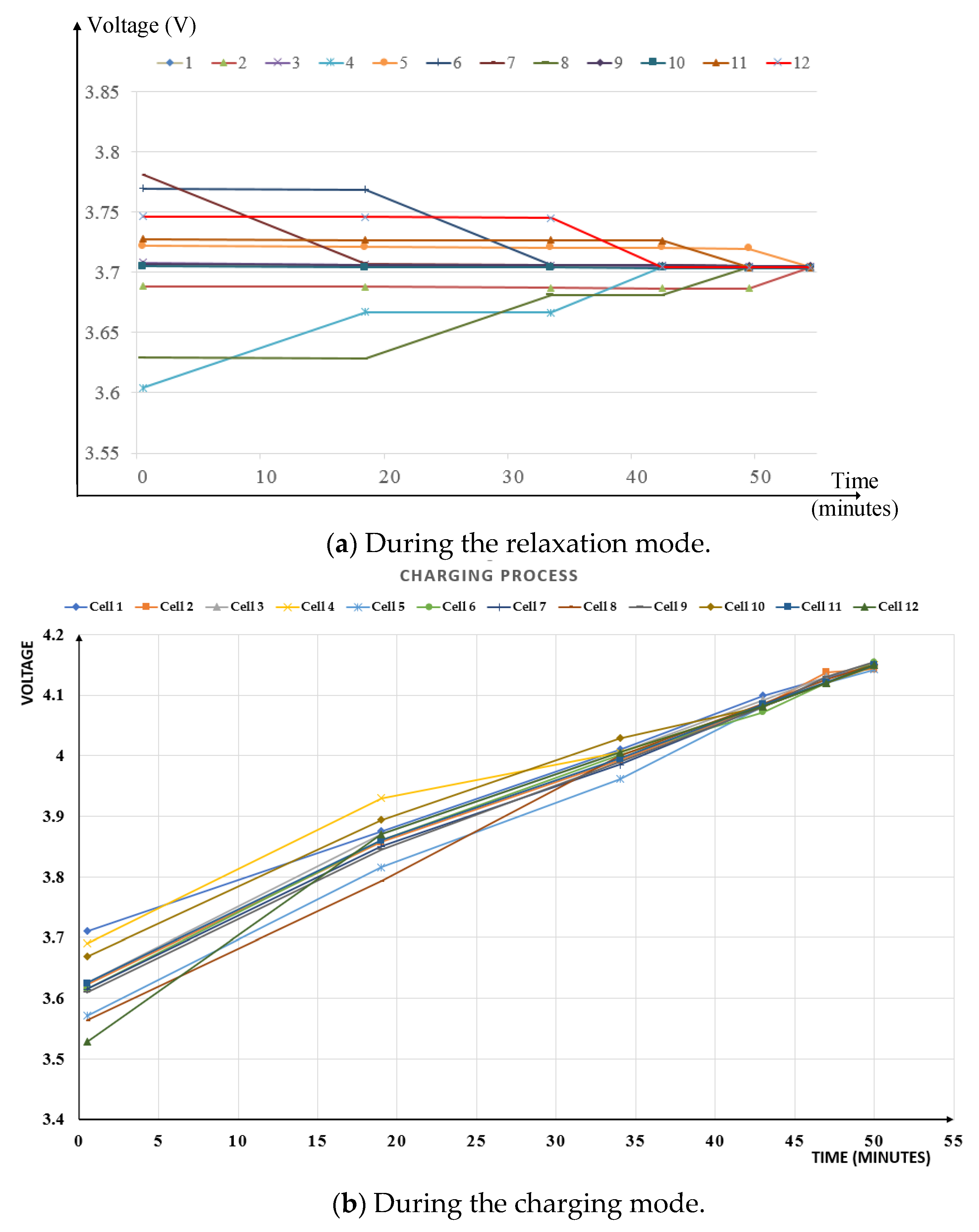A Low Cost and Fast Cell-to-Cell Balancing Circuit for Lithium-Ion Battery Strings
Abstract
:1. Introduction
2. Proposed Cell Balancing Circuit
2.1. Structure of the Proposed Cell-to-Cell Balancing Circuit
2.2. Considering Transient Voltage Due to The Balancing Current
2.3. Operation Principle of the Proposed Balancing Method
3. Experimental Setup and Results
3.1. Experimental Results of the Push–Pull Converter
3.2. Experimental Results of the Cell Balancing Operation of the Proposed Circuit
3.3. Comparison between the Proposed and Conventional Cell Balancing Methods
4. Conclusions
Author Contributions
Funding
Conflicts of Interest
References
- Affanni, A.; Bellini, A.; Franceschini, G.; Guglielmi, P.; Tassoni, C. Battery Choice and Management for New-Generation Electric Vehicles. IEEE Trans. Power Electron. 2005, 52, 1343–1349. [Google Scholar] [CrossRef] [Green Version]
- Available online: https://en.wikipedia.org/wiki/Tesla_Roadster#Battery_system (accessed on 19 December 2007).
- Lukic, S.M.; Cao, J.; Bansal, R.C.; Rodriguez, F.; Emadi, A. Energy Storage Systems for Automotive Applications. IEEE Trans. Ind. Electron. 2008, 55, 2258–2267. [Google Scholar] [CrossRef]
- Daowd, M.; Omar, N.; Van Den Bossche, P.; Van Mierlo, J. Passive and Active Battery Balancing Comparison Based on Matlab Simulation. In Proceedings of the 2011 IEEE Vehicle Power and Propulsion Conference, Chicago, IL, USA, 6–9 September 2011; pp. 1–7. [Google Scholar]
- Imtiaz, A.M.; Khan, F.H. Time Shared Flyback Converter Based Regenerative Cell Balancing Technique for Series Connected Li-Ion Battery Strings. IEEE Trans. Power Electron. 2013, 28, 5960–5975. [Google Scholar] [CrossRef]
- Park, H.S.; Kim, C.E.; Moon, G.W.; Lee, J.H.; Oh, J.K. Two-Stage Cell Balancing Scheme for Hybrid Electric Vehicle Lithium-Ion Battery Strings. In Proceedings of the 2007 IEEE Power Electronics Specialists Conference, Orlando, FL, USA, 17–21 June 2007; pp. 273–279. [Google Scholar]
- Lim, C.S.; Lee, K.J.; Ku, N.J.; Hyun, D.S.; Kim, R.Y. A Modularized Equalization Method Based on Magnetizing Energy for a Series-Connected Lithium-Ion Battery String. IEEE Trans. Power Electron. 2014, 29, 1791–1799. [Google Scholar] [CrossRef]
- Park, H.S.; Kim, C.E.; Kim, C.H.; Moon, G.W.; Lee, J.H. A Modularized Charge Equalizer for an Hev Lithium-Ion Battery String. IEEE Trans. Ind. Electron. 2009, 56, 1464–1476. [Google Scholar] [CrossRef]
- Kim, C.H.; Kim, M.Y.; Moon, G.W. A Modularized Charge Equalizer Using a Battery Monitoring Ic for Series-Connected Li-Ion Battery Strings in Electric Vehicles. IEEE Trans. Power Electron. 2013, 28, 3779–3787. [Google Scholar] [CrossRef]
- Ye, Y.; Cheng, K.W. Modeling and Analysis of Series–Parallel Switched-Capacitor Voltage Equalizer for Battery/Super capacitor Strings. IEEE J. Emerg. Sel. Top. Power Electron. 2015, 3, 977–983. [Google Scholar] [CrossRef]
- Henry, J.M.; Kimball, J.W. Practical Performance Analysis of Complex Switched-Capacitor Converters. IEEE Trans. Power Electron. 2011, 26, 127–136. [Google Scholar] [CrossRef]
- Kim, M.Y.; Kim, C.H.; Kim, J.H.; Moon, G.W. A Chain Structure of Switched Capacitor for Improved Cell Balancing Speed of Lithium-Ion Batteries. IEEE Trans. Ind. Electron. 2014, 61, 3989–3999. [Google Scholar] [CrossRef]
- Baughman, A.C.; Ferdowsi, M. Double-Tiered Switched-Capacitor Battery Charge Equalization Technique. IEEE Trans. Power Electron. 2008, 55, 2277–2285. [Google Scholar] [CrossRef]
- Uno, M.; Tanaka, K. Influence of High-Frequency Charge–Discharge Cycling Induced by Cell Voltage Equalizers on the Life Performance of Lithium-Ion Cells. IEEE Trans. Power Electron. 2011, 60, 1505–1515. [Google Scholar] [CrossRef]
- Dong, B.; Li, Y.; Han, Y. Parallel Architecture for Battery Charge Equalization. IEEE Trans. Power Electron. 2015, 30, 4906–4913. [Google Scholar] [CrossRef]
- Kutkut, N.H. A modular nondissipative current diverger for EV battery charge equalization. Proc. IEEE Appl. Power Electron. Conf. 1998, 2, 686–690. [Google Scholar]
- Mestrallet, F.; Kerachev, L.; Crebier, J.C.; Collet, A. Multiphase Interleaved Converter for Lithium Battery Active Balancing. IEEE Trans. Power Electron. 2014, 29, 2874–2881. [Google Scholar] [CrossRef]
- Lee, Y.S.; Cheng, G.T. Quasi-Resonant Zero-Current-Switching Bidirectional Converter for Battery Equalization Applications. IEEE Trans. Power Electron. 2006, 21, 1213–1224. [Google Scholar] [CrossRef]
- Speltino, C.; Stefanopoulou, A.; Fiengo, G. Cell Equalization in Battery Stacks through State of Charge Estimation Polling. In Proceedings of the 2010 American Control Conference, Baltimore, MD, USA, 30 June–2 July 2010; pp. 5050–5055. [Google Scholar]
- Park, S.H.; Kim, T.S.; Park, J.S.; Moon, G.W.; Yoon, M.J. A New Buck-Boost Type Battery Equalizer. In Proceedings of the 2009 Twenty-Fourth Annual IEEE Applied Power Electronics Conference and Exposition, Washington, DC, USA, 15–19 February 2009; pp. 1246–1250. [Google Scholar]
- Villa, L.F.L.; Pichon, X.; Sarrafin-Ardelibi, F.; Raison, B.; Crebier, J.C.; Labonne, A. Toward the Design of Control Algorithms for a Photovoltaic Equalizer: Choosing the Optimal Switching Strategy and the Duty Cycle. IEEE Trans. Ind. Electron. 2014, 29, 1447–1460. [Google Scholar] [CrossRef]
- Lee, K.M.; Chung, Y.C.; Sung, C.H.; Kang, B. Active Cell Balancing of Li-Ion Batteries Using LC Series Resonant Circuit. IEEE Trans. Ind. Electron. 2015, 62, 5491–5501. [Google Scholar] [CrossRef]
- Park, S.H.; Park, K.B.; Kim, H.S.; Moon, G.W.; Youn, M.J. Single-Magnetic Cell-to-Cell Charge Equalization Converter with Reduced Number of Transformer Windings. IEEE Trans. Power Electron. 2012, 27, 2900–2911. [Google Scholar] [CrossRef]
- Chen, Y.; Liu, X.; Cui, Y.; Zou, J.; Yang, S. A MultiWinding Transformer Cell-to-Cell Active Equalization Method for Lithium-Ion Batteries with Reduced Number of Driving Circuits. IEEE Trans. Power Electron. 2016, 31, 4916–4929. [Google Scholar]
- Pham, V.L.; Khan, A.B.; Nguyen, T.T.; Choi, W. A low cost, small ripple, and fast balancing circuit for lithium-ion battery strings. In Proceedings of the 2016 IEEE Transportation Electrification Conference and Expo, Asia-Pacific (ITEC Asia-Pacific), Busan, Korea, 1–4 June 2016; pp. 861–865. [Google Scholar]
- Pham, V.L.; Nguyen, T.T.; Tran, D.H.; Vu, V.B.; Choi, W. A new cell-to-cell fast balancing circuit for Lithium-ion batteries in Eelectric Vehicle and Energy Storage System. In Proceedings of the 2016 IEEE 8th International Power Electronics and Motion Control Conference (IPEMC-ECCE Asia), Hefei, China, 22–26 May 2016; pp. 2461–2465. [Google Scholar]
- Hart, D.W. Power Electronic Published by McGraw-Hill; A Business Unit of The McGraw-Hill Companies Inc.: New York, NY, USA, 2011. [Google Scholar]
- He, H.; Xiong, R.; Fan, J. Evaluation of Lithium-Ion Battery Equivalent Circuit Models for State of Charge Estimation by an Experimental Approach. Energies 2011, 4, 582–598. [Google Scholar] [CrossRef]
- Waag, W.; Käbitz, S.; Sauer, D.U. Experimental investigation of the lithium-ion battery impedance characteristic at various conditions and aging states and its influence on the application. Appl. Energy 2013, 102, 885–897. [Google Scholar] [CrossRef]
- Kim, J.; Shin, J.; Chun, C.; Cho, B.H. Stable Configuration of a Li-Ion Series Battery Pack Based on a Screening Process for Improved Voltage/SOC Balancing. IEEE Trans. Power Electron. 2012, 27, 411–424. [Google Scholar] [CrossRef]
- Kim, J.H.; Lee, S.J.; Lee, J.M.; Cho, B.H. A new direct current internal resistance and state of charge relationship for the Li-ion battery pulse power estimation. In Proceedings of the 2007 7th International Conference on Power Electronics, Daegu, Korea, 22–26 October 2007. [Google Scholar]
- Barsukov, Y.; Qian, J. Battery Power Management for Portable Devices; Atech Hourse: Boston, MA, USA, 2013. [Google Scholar]











| Balancing Method | Component Counts | Characteristics | ||||||
|---|---|---|---|---|---|---|---|---|
| Switch | Photo-Coupler/Pulse Trans. | Diode | Ind. | Cap. | Trans. | |||
| Cell-to-pack [5] | 2N-2 | 2N-2 | 2N-2 | 0 | 0 | m | Requires many steps to balance causing a slow balancing speed, especially for the low voltage cells. | |
| Pack-to-cell [8] | N *+N/2 | N | N | 0 | 0 | N/2 | Requires many steps to balance causing a slow balancing speed, especially for the high voltage cells. | |
| Cell-to-pack-to-cell [9] | 2N * | 2N | 2 | 0 | 0 | 2 | Faster than the cell-to-pack and pack-to-cell methods, but still takes a long time to balance the cells. | |
| Adjacent cell-to-cell | Switched Cap. [10] | 4N * | 4N | 0 | 0 | N | 0 | Impossible to control the balancing current and, hence, the balancing speed is slow. |
| Improved switched Cap. [12] | N+2 * | N+2 | 0 | 0 | N+1 | 0 | ||
| Switched inductor [15] | 2N | 2N | 0 | N | 0 | 0 | ||
| Quasi-resonant [18] | 2N | 2N | 0 | 2N | N | 0 | Possesses a higher efficiency due to soft switching, but the balancing speed is low because it is impossible to control the balancing current. | |
| Direct cell-to-cell | Single Cap. [19] | N+1 * | N+1 | 0 | 0 | 1 | 0 | Impossible to control the balancing current through the capacitor or inductor, hence the balancing speed is slow. |
| Single Ind. [20] | 2N | 2N | 2N | 1 | 0 | 0 | ||
| LC resonant [22] | N+10 * | N+10 | 0 | 1 | 1 | 0 | Highly efficient due to the soft switching. | |
| Multi-winding [24] | 2N * | 2N | 0 | 0 | 0 | 1 | Complex in implementation for many cells. | |
| Parameters | Manufacturer | |
|---|---|---|
| Push-pull Converter | Transformer | PA6383 |
| MOSFET | AOB290L | |
| Schottky diode | CDBA240LL | |
| Gate driver | TLP250 | |
| Monitoring | Monitoring IC | Bq76940 |
| Shunt resistor | WSR21L000FEA | |
| Cell selection switches | Relay | TQ2-5V |
| Transistor array | ULN2803A | |
| Cell Balancing Methods | Cost | Balancing Speed | Efficiency | Complexity in Control | Complexity in Implementation |
|---|---|---|---|---|---|
| Cell-to-pack [5] | High | Low | Average | Complex | Simple |
| Pack-to-cell [8] | Low | Low | Low | Complex | Average |
| Cell-to-pack-to-cell [9] | High | Average | Average | Simple | Simple |
| Switched capacitor [10] | High | Low | Low | Simple | Average |
| Improved switched capacitor [12] | Low | Average | Low | Average | Average |
| Switched inductor [15] | High | Low | Low | Simple | Average |
| Quasi-resonant [18] | High | Low | Average | Average | Complex |
| Single capacitor [19] | High | Low | Average | Simple | Simple |
| Single inductor [20] | High | Average | Average | Simple | Average |
| LC resonant [22] | Average | Average | High | Simple | Simple |
| Multi-winding [24] | High | Average | Average | Simple | Complex |
| Proposed method | Low | High | High | Simple | Simple |
© 2020 by the authors. Licensee MDPI, Basel, Switzerland. This article is an open access article distributed under the terms and conditions of the Creative Commons Attribution (CC BY) license (http://creativecommons.org/licenses/by/4.0/).
Share and Cite
Pham, V.-L.; Duong, V.-T.; Choi, W. A Low Cost and Fast Cell-to-Cell Balancing Circuit for Lithium-Ion Battery Strings. Electronics 2020, 9, 248. https://doi.org/10.3390/electronics9020248
Pham V-L, Duong V-T, Choi W. A Low Cost and Fast Cell-to-Cell Balancing Circuit for Lithium-Ion Battery Strings. Electronics. 2020; 9(2):248. https://doi.org/10.3390/electronics9020248
Chicago/Turabian StylePham, Van-Long, Van-Tinh Duong, and Woojin Choi. 2020. "A Low Cost and Fast Cell-to-Cell Balancing Circuit for Lithium-Ion Battery Strings" Electronics 9, no. 2: 248. https://doi.org/10.3390/electronics9020248





